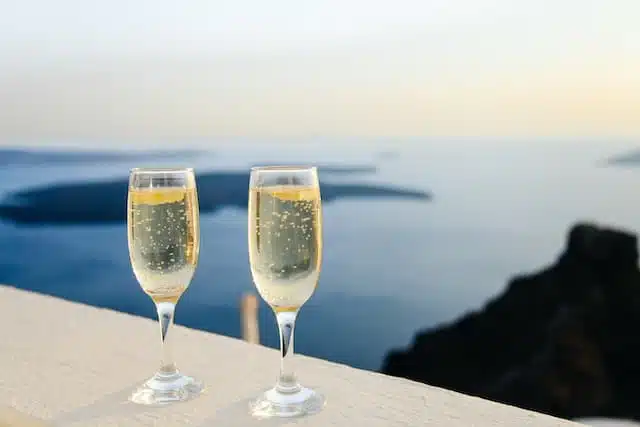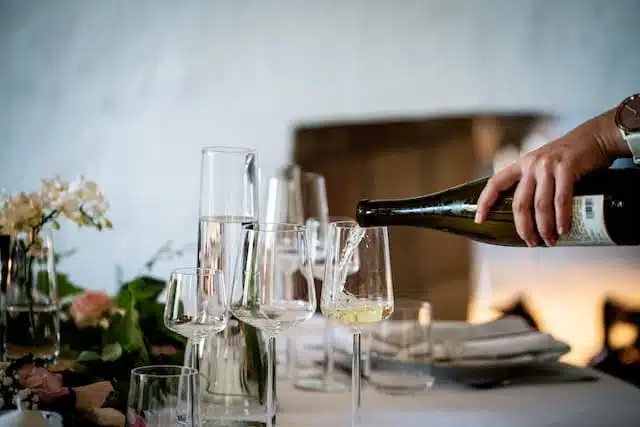Cava
Cava to enjoy longer with Bubbl.
What is a Spanish Cava?
This delicious Spanish sparkling wine deserves your full attention. The term ‘Cava’, which means ‘cellar’ or ‘wine cellar’ in Catalan and Spanish, refers to the underground cellars where this Spanish sparkling wine was traditionally stored during its ageing process.
It is produced using the traditional method (also known as the méthode champenoise) in which the second fermentation (which creates the bubbles) takes place in the bottle. The name ‘Cava’ was adopted for this sparkling wine in 1970, in reference to its ageing cellars.

Generally known as brut, these ‘cava’ wines are produced exclusively in Spain. Depending on how long they are aged in the bottle, there are three main families: Cava (minimum 9 months), Cava Reserva (minimum 15 months) and Cava Gran Reserva, which must be aged for at least 30 months in the bottle at the same bodega.
The price of Brut is much more affordable than Champagne because of the length of time it is aged (15 months in the cellar and a minimum of three years in Champagne for vintage wines). Opinions differ, but this Spanish wine offers excellent value for money.
Its fine bubbles, fruity and floral aromas and distinct range of flavours make it an excellent alternative to champagne. But how can you enjoy it without having to finish it all at once? The answer is simple: use the Bubbl. system for preserving sparkling wines.
Enjoy your Cava at your own pace
Thanks to Bubbl., there’s no need to finish a bottle in a single evening. Bubbl. is a sparkling wine preservation device that allows you to keep a bottle open for up to a week, while preserving the sparkling characteristics and taste of the wine.
Whether you enjoy brut nature, extra dry or sweet, Bubbl. will help you preserve these sparkling wines by maintaining their bubbles and protecting them from oxidation.

How does Bubbl. preserve sparkling wine?
Bubbl. uses a mixture of oenological gases, 80% CO2 and 20% nitrogen, to compress the gas in the bottle and protect the wine from oxidation. The Smart Cap ensures a perfect seal, preserving the freshness and effervescence of the Cava.
Bubbl., a must-have accessory for Cava lovers
If you’re a Cava lover, Bubbl. is an essential tasting accessory. It will allow you to enjoy your bottle of Cava over several days without compromising the quality of the wine. Enjoy your Cava the way you want, when you want, while preserving every aromatic note of this exceptional sparkling wine.
In short, if you’re looking for the best way to store your bottle of Cava, look no further: Bubbl. is the ideal solution for you. With Bubbl. the pleasure of Cava is prolonged.
FAQs:
What’s the difference between Cava and Prosecco?
Cava and Prosecco are two types of sparkling wine that come from different regions and are produced using different methods. Although both are often drunk as alternatives to champagne, there are significant differences between them.
- Origin: Cava comes from Spain, mainly the Catalonia region, while Prosecco is an Italian sparkling wine from the Veneto region.
- Grape varieties: Cava is mainly made from Macabeu, Parellada and Xarel-lo grapes, while Prosecco is made from Glera grapes.
- Production method: Cava is produced using the traditional method (or méthode champenoise), where the second fermentation (which produces the bubbles) takes place in the bottle. This is the same method used for champagne. Prosecco, on the other hand, is generally produced using the Charmat method, where the second fermentation takes place in stainless steel tanks before bottling.
- Taste: Because of these differences, they have distinct flavour profiles. Cava often has a more complex flavour and can have notes of green apple, pear and lemon with hints of toast due to its ageing on the lees. Prosecco tends to be more fruity and floral, with notes of apple, pear, peach, melon and white flowers.
These differences can certainly affect your choice of sparkling wine, depending on your taste preferences and the type of meal you plan to serve it with.
How to drink it?
Tasting Cava, like any sparkling wine, can be an enriching and tasty experience with a personal touch. Here’s a simple method:
- Preparing the glass: Choose a champagne glass or flute, which are designed to retain the bubbles and concentrate the aromas.
- Adding flavour: Pour a dash of lemon juice and a touch of liquid honey into each glass. Mixing: Stir gently until the honey has completely dissolved.
- Adding the Cava: Top up slowly with the Cava, pouring it slowly over the side of the glass to retain as many bubbles as possible.
- Decoration: Add the finishing touch with a few edible violets for an elegant presentation.
- Tasting: Take your time to enjoy the effervescent bubbles and subtle, complex aromas.
If you can’t finish your bottle of Cava, don’t forget to use your Bubbl. to preserve its effervescence and flavours for future tasting.
Where is it made?
Cava is a sparkling wine produced in Spain. Although Cava can be produced in several wine-growing regions across the country, the vast majority (over 95%) is produced in Catalonia, in the Penedès region to the south-west of Barcelona.
The town of Sant Sadurní d’Anoia, in particular, is considered to be the birthplace of wine. Some of the largest and oldest wineries are located here, including Codorníu and Freixenet.

